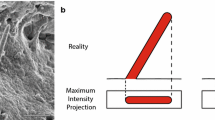Summary
We have created a method for measuring the orientation of cilia in the respiratory epithelium. Ciliary orientation is the direction perpendicular to the plane defined by the central tubules of the cilia and is an estimate of ciliary beat direction. Ciliary orientation can be estimated by measuring the angle between the plane defined by the central tubules and a reference line. The standard deviation of these measurements describes the variation present in the beat directions of the cilia. The reference line must be so chosen that the majority of measurements falls at about the middle of the 0°–180° range. We tested measurements by using both a glass angle measure and a semiautomatic image analyzer (IBAS I). The latter approach was faster and more reproducible. We made our measurements of normal tissues on samples obtained from two healthy adult non-smokers. Measurements were made in four areas of each sample, with 59–110 cilia in each. The differences between the maximum and minimum angles of the ciliary orientation in the same area varied from 167.9° to 85.4° from the reference line. The standard deviation varied from 18.0° to 35.4° and we consider this to be a normal variation in ciliary orientation. Of the cilia, 57% were within a standard deviation of 20°.
Similar content being viewed by others
References
Afzelius BA (1976) A human syndrome caused by immotile cilia. Science 193:317–319
Afzelius BA (1981) The “immotile cilia syndrome” and other ciliary abnormalities induced by infection and injury. Am Rev Respir Dis 124:107–109
Ailsby RL, Ghadially FN (1973) Atypical cilia in human bronchial mucosa. J Pathol 109:75–78
Camner P (1971) The production and use of test aerosols for studies of human tracheobronchial clearance. Environ Physiol 1:137–154
Carson JL, Collier AM, Hu SS (1985) Acquired ciliary defects in nasal epithelium of children with acute viral upper respiratory infections. N Engl J Med 312:463–468
Eliasson R, Mossberg B, Camner P, Afzelius BA (1977) The immotile cilia syndrome. N Engl J Med 297:1–6
Fisher TJ, McAdams JA, Entis GN, Cotton R, Ghory JE, Ausdenmoore RW (1978) Middle ear ciliary defect in Kartagener's syndrome. Pediatrics 62:443–445
Herzon F (1981) Upper respiratory tract ciliary ultrastructural pathology. Ann Otol Rhinol Laryngol 90:1–12
Jahrsdoerfer R, Feldman PS, Rubel EW, Guerrant JL, Eggleston PA, Selden RF (1979) Otitis media and the immotile cilia syndrome. Laryngoscope 89:769–778
Kärjä J, Nuutinen J, Karjalainen P (1982) Radioisotopic method for measurement of nasal mucociliary activity. Arch Otolaryngol 108:99–101
Katz SM, Damjanov I, Carver J, Spitzer S, Mason D, Kauffman LA, Solnick P (1977) Kartagener's syndrome and abnormal cilia. N Engl J Med 297:1011–1012
McDowell EM, Barret LA, Harris CC, Trump FT (1976) Abnormal cilia in human bronchial epithelium. Arch Pathol Lab Med 100:429–436
Mossberg B, Afzelius BA, Eliasson R, Camner P (1978) On the pathogenesis of obstructive lung disease. A study on immotile-cilia syndrome. Scand J Respir Dis 59:55–65
Nickels J, Tahkokallio O, Tukiainen P (1980) The immotile cilia syndrome. Duodecim 96:857–862
Nuutinen J Kärjä J, Karjalainen P (1983) Measurements of impaired mucociliary function in children. Eur J Respir Dis [Suppl] 128:454–456
Pedersen H, Mygind N (1976) Absence of axonemal arms in nasal mucosa cilia in Kartagener's syndrome. Nature 262:494–495
Pedersen M, Mygind N (1980) Ciliary motility in the immotile cilia syndrome. Br J Dis Chest 74:239–244
Pedersen H, Rebbe H (1975) Absence of arms in the axoneme of immobile human spermatozoa. Biol Reprod 12:541–544
Rautiainen M, Collan Y, Nuutinen J, Kärjä J (1984) Ultrastructure of human respiratory cilia: a study based on serial sections. Ultrastruct Pathol 6:331–339
Rossman C, Forrest J, Newhouse M (1980) Motile cilia in “immotile cilia” syndrome. Lancet I:1360
Rutland J, Cole PJ (1980) Non-invasive sampling of nasal cilia for measurement of beat frequency and study of ultrastructure. Lancet I:564–565
Rutland J, Cole PJ (1980) Ciliary dyskinesia. Lancet II:859
Satir P (1965) Studies on cilia II. Examination of the ciliary shaft and the role of the filaments in motility. J Cell Biol 26:305–384
Satir P (1968) Studies on cilia III. Further studies on the cilium tip and a sliding filament model of ciliary motility. J Cell Biol 39:77–94
Sturgess JM, Chao J, Wong J, Aspin N, Turner JAP (1979) Cilia with defective radial spokes. N Engl J Med 300:53–56
Author information
Authors and Affiliations
Rights and permissions
About this article
Cite this article
Rautiainen, M., Collan, Y. & Nuutinen, J. A method for measuring the orientation (“beat direction”) of respiratory cilia. Arch Otorhinolaryngol 243, 265–268 (1986). https://doi.org/10.1007/BF00464443
Received:
Accepted:
Issue Date:
DOI: https://doi.org/10.1007/BF00464443




